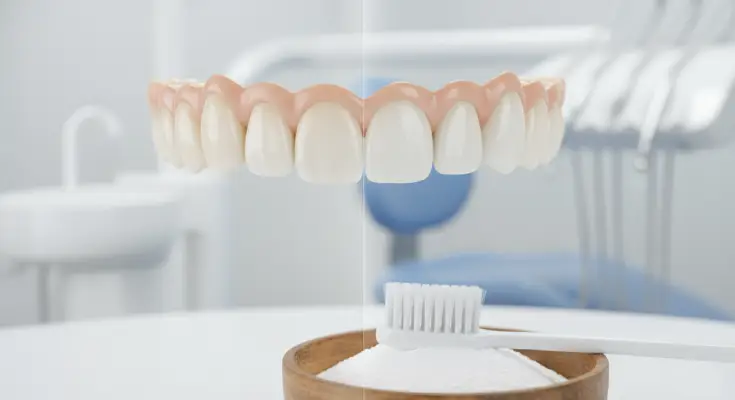Does Baking Soda Whiten Teeth? The Complete Evidence-Based Answer
Baking soda can, in fact, slightly whiten teeth. It doesn’t bleach your teeth or make them completely white, but it does help remove surface stains from things like tea and coffee so your teeth appear a little brighter. Consider it a mild cleanser rather than a miracle whitening solution. Only when used properly will it work on the outside of the teeth. Therefore, it does help, but only slightly and not as quickly or powerfully as people believe.
Understanding the Two Types of Tooth Discoloration
It’s crucial to identify the types of stains you have before attempting to whiten them with baking soda. Baking soda only works on specific types of stains, and not all stains are the same. This is the simple explanation.
Extrinsic stains (surface only):
These stains sit on the outside of your teeth. They come from things like coffee, tea, red wine, curry, smoking, and other dark foods. If you want a deeper whitening option for these stains, you can also consider professional teeth whitening in NYC. They stay on the enamel’s top layer, called the pellicle. Because they are only on the surface, they can often be cleaned or polished off. Baking soda can help here because it gently scrubs these outer stains and makes the teeth look a bit brighter.
Intrinsic stains (inside the tooth):
These stains are deep inside the tooth, not on the surface. They can happen from genetics, certain medicines like tetracycline, too much fluoride in childhood, trauma, or natural aging. Baking soda cannot reach these deeper stains at all because they are under the enamel. Only peroxide-based whitening can lighten these, especially treatments like in-office dental whitening, which are designed to target deeper stains.
Simple example: Baking soda can help if years of coffee or tea have left your teeth yellow-brown. However, baking soda won’t help if your teeth have deep medication stains or are naturally gray.
How Baking Soda Whitens Teeth: The Science
Understanding what baking soda actually does in your mouth will help you understand why it can aid with teeth whitening. Both components work together to remove stains, and the procedure is straightforward. This is a simple explanation of how baking soda actually affects your teeth.
1. Mild mechanical abrasion
This implies that you can gently clean your teeth with baking soda. In comparison to most whitening toothpastes, it is incredibly soft. The RDA score for baking soda is extremely low, ranging from 7 to 35. The price of many whitening toothpastes is significantly higher, ranging from 100 to 150.
Baking soda can clean the top layer of your teeth without damaging the enamel because it is so mild. It aids in the removal of the pellicle, a thin, stained layer. Coffee, tea, red wine, and food stains adhere here. Your teeth appear slightly whiter after this outer layer is cleaned.
2. Chemical effect
With a pH of roughly 8.3, baking soda is somewhat alkaline. This implies that it can aid in balancing oral acids. Dangerous bacteria cannot proliferate as readily when your mouth is less acidic. These bacteria frequently produce odors and stains.
Thus, baking soda not only removes stains from your mouth but also makes it healthier and cleaner. This prevents the accumulation of new stains too quickly.
Key evidence
- A big study in 2017 from the Journal of the American Dental Association looked at 21 tests. It found that toothpastes with baking soda clean stains better than toothpastes without baking soda. The study also said baking soda does not damage enamel or dentin when used correctly.
- Many other studies from 2008 to 2023 show the same thing: people got 1–2 shades lighter after using baking soda products for a few weeks.
- The American Dental Association (ADA) also says baking soda is safe and works well for removing surface stains when used in toothpaste.
Realistic Results You Can Expect

Improvement:
Baking soda can make your teeth 1–2 shades lighter. This means your teeth will look a little brighter, but not super white. The change is small and natural.
Time frame:
Most people start to notice a difference in 1–2 weeks. The best results usually happen after 4–6 weeks of regular use.
Duration:
The brightness does not last long if you keep drinking coffee, tea, or red wine. Regular dental cleanings can help maintain the results. Stains can come back fast if you don’t follow good habits. Baking soda helps, but you still need to take care of your teeth to keep them bright.
Safety Profile and Real Risks
A gentle cleaner is baking soda. For this reason, it is regarded by many dentists as one of the gentlest abrasives. It helps remove surface stains without causing much pain when used infrequently and gently. However, when people use it too frequently, too strongly, or combine it with acids, issues arise.
1) Over-brushing with pure baking soda every day
- What happens: If you brush with straight baking soda every day and scrub hard, the top hard layer of your tooth (enamel) can slowly wear away.
- Why it’s bad: Enamel is the tooth’s protective shell. Under it is dentin, which is more yellow. If enamel gets thinner, the yellow dentin shows through, and your teeth look more yellow, not whiter. Read more about tooth erosion at the gum line to understand how enamel loss progresses.
- How fast: It’s slow. Damage builds up over months or years, not overnight. But daily misuse speeds it up.
- How to avoid: Don’t use pure baking soda daily. Use a small amount 1–2 times a week at most, brush gently, and use a soft toothbrush.
2) Using baking soda without fluoride
- What fluoride does: Fluoride in toothpaste helps strengthen enamel and makes teeth less likely to get cavities.
- Why baking soda alone can be a problem: If you replace a fluoride toothpaste with plain baking soda all the time, you miss out on that protection. Over months and years, this can raise the chance of cavities.
- How to avoid: Use baking-soda toothpaste that also contains fluoride, or alternate: regular fluoride toothpaste daily, and baking soda only sometimes.
3) Mixing baking soda with acidic ingredients
- Examples people use: Lemon juice, vinegar, or strawberry mash mixed with baking soda are common home hacks.
- What the acid does: Acid softens and weakens enamel by dissolving tiny bits of the calcium that make enamel hard.
- What the baking soda does then: The abrasive action, even gentle, can scrub away that softened enamel more easily. Together, they cause fast enamel loss.
- Real result: Faster, noticeable enamel erosion, sensitivity, and more yellow-looking teeth. If you’re already seeing white or chalky spots, here’s what you need to know about white spots on teeth.
- Rule: Never mix baking soda with acids. Dentists and the ADA advise against it.
Signs your enamel might be getting damaged
- Teeth feel sharp or twinge with hot/cold sweets or drinks (sensitivity).
- Teeth look more yellow over time, not brighter. If this keeps happening, it may be time to schedule a dental checkup.
- Edges of teeth look thinner or more translucent (see-through).
- Rough or uneven areas on the tooth surface.
If you notice these, stop the DIY baking soda and see a dentist.
Who Should Avoid It
- Existing tooth sensitivity or exposed roots. Sensitivity can worsen without proper care, so learning the causes of bleeding gums and sensitivity can help.
- Thin enamel (genetic or from acid erosion)
- Large restorations, crowns, or veneers can create uneven color.
- Braces or clear aligners
Safe, Dentist-Approved Ways to Use Baking Soda
It’s crucial to use the proper techniques if you want to use baking soda safely. Baking soda is permitted by dentists, but only under certain conditions. These are the safest, dentist-approved methods to reap the rewards without damaging your teeth.
Method 1 | Safest & Most Recommended (ADA-approved)
This is the best and safest way. Just put a tiny pinch of baking soda on top of your regular fluoride toothpaste. Do this 2–3 times a week. Brush gently for 2 minutes. You get the stain-cleaning power of baking soda and the tooth protection from fluoride at the same time. Pairing this with a healthy morning routine for your gums improves results.
Method 2 | Occasional Pure Paste
One teaspoon of baking soda and a few drops of water can be combined to create a basic paste. Just once or twice a week, use this in place of toothpaste. Don't use it all the time. To keep your teeth strong, always brush with fluoride toothpaste after using the paste.
Method 3 | Best Long-Term Option
Using a baking soda toothpaste daily is the safest long-term option. Products like Arm & Hammer, Colgate Baking Soda & Peroxide, and Tom’s of Maine are gentle, tested, and give steady whitening with very little risk. For long-term aesthetic improvements, explore cosmetic dentistry options.
Baking Soda vs Other Whitening Methods
| Method | Whitening Power | Speed | Safety | Cost | Best For |
|---|---|---|---|---|---|
| Pure baking soda (DIY) | Low-Moderate | 2-6 weeks | Moderate | <$2 | Light surface stains, budget |
| Baking soda toothpaste | Moderate | 2-4 weeks | Very High | $3-8 | Daily maintenance |
| OTC peroxide strips/gels | High | 7-21 days | High | $20-60 | Noticeable whitening |
| Professional in-office | Very High | 1-2 hours | Highest | $300-1000 | Dramatic, long-lasting |
Conclusion
If used properly, baking soda can be a good option for whitening. It works best for people without sensitive teeth and for light surface stains. However, peroxide-based whitening will always be more effective if you want a significant color shift or have deeper stains.
For most people, the smartest plan is to use a baking soda toothpaste a few times a week, keep up with professional dental cleanings, and consider a smile makeover if they want a noticeable color change. With good brushing, flossing, and simple habits like using a straw for staining drinks, you can keep your smile bright and healthy without harming your enamel.
FAQs
1. How fast does baking soda whiten teeth?
Baking soda usually shows a small whitening change in about 1–2 weeks, but the best results appear around 4–6 weeks with regular, safe use.
2. Can I use baking soda on my teeth every day?
You should not use pure baking soda every day because it can slowly thin your enamel. However, ADA-approved baking soda toothpastes are safe for daily use.
3. Is using baking soda and lemon together safe for whitening teeth?
No. Mixing baking soda with lemon is unsafe because lemon is acidic and softens enamel, making it much easier for the baking soda to wear it away quickly.
4. Will baking soda damage my crowns or veneers?
Baking soda usually does not harm crowns or veneers, but it can make older porcelain look dull over time. If you have dental work, ask your dentist first.
5. Does baking soda remove tartar from teeth?
No. Baking soda can clean surface stains, but cannot remove tartar. Tartar is hardened plaque and needs to be removed professionally by a dentist or hygienist.

Dr. Alexander Heifitz (Author)
Dr. Alexander Heifitz is the founder of 65 Broadway Dental in NYC, where he combines advanced dental expertise with a patient-first approach. He specializes in cosmetic and restorative treatments such as dental implants, veneers, Invisalign, and smile makeovers, helping New Yorkers achieve both oral health and confidence.
Booking An Appointment
Looking for a reliable dentist in Downtown NYC? Whether you need a routine cleaning, urgent care, or a full smile transformation — we’ve got you covered. We accept most PPO insurance plans and offer flexible scheduling.
+1 (212) 430-3888
Call for appointment
Walk-ins Welcome / Same-Day Appointments Available

Related Blogs

Comparing the Top 5 Types of Dental Crowns
Compare the top 5 dental crowns, metal, resin, porcelain, ceramic, and zirconia, to find the best fit for strength, look, and cost.
Read More
8 Steps to Perfect Your Brushing Technique Tonight
Perfect your brushing tonight with 8 dentist-approved steps for cleaner teeth, healthier gums, and a brighter, cavity-free smile.
Read More